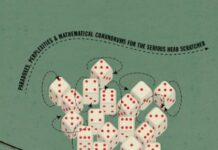
Ebook Info
- Published: 2010
- Number of pages: 286 pages
- Format: PDF
- File Size: 2.53 MB
- Authors: Paul J. Nahin
Description
Today complex numbers have such widespread practical use–from electrical engineering to aeronautics–that few people would expect the story behind their derivation to be filled with adventure and enigma. In An Imaginary Tale, Paul Nahin tells the 2000-year-old history of one of mathematics’ most elusive numbers, the square root of minus one, also known as i. He recreates the baffling mathematical problems that conjured it up, and the colorful characters who tried to solve them.In 1878, when two brothers stole a mathematical papyrus from the ancient Egyptian burial site in the Valley of Kings, they led scholars to the earliest known occurrence of the square root of a negative number. The papyrus offered a specific numerical example of how to calculate the volume of a truncated square pyramid, which implied the need for i. In the first century, the mathematician-engineer Heron of Alexandria encountered I in a separate project, but fudged the arithmetic; medieval mathematicians stumbled upon the concept while grappling with the meaning of negative numbers, but dismissed their square roots as nonsense. By the time of Descartes, a theoretical use for these elusive square roots–now called “imaginary numbers”–was suspected, but efforts to solve them led to intense, bitter debates. The notorious i finally won acceptance and was put to use in complex analysis and theoretical physics in Napoleonic times.Addressing readers with both a general and scholarly interest in mathematics, Nahin weaves into this narrative entertaining historical facts and mathematical discussions, including the application of complex numbers and functions to important problems, such as Kepler’s laws of planetary motion and ac electrical circuits. This book can be read as an engaging history, almost a biography, of one of the most evasive and pervasive “numbers” in all of mathematics.Some images inside the book are unavailable due to digital copyright restrictions.
User’s Reviews
Reviews from Amazon users which were colected at the time this book was published on the website:
⭐This book provides an interesting history on the square root of -1. The author describes how square roots of negative values were used to solve cubic equations, describes how the geometrical interpretation came about, and ends with more advanced topics in electrical engineering and complex function theory. It also describes the Riemann Hypothesis, the greatest unsolved problem in mathematics.Unfortunately, this book is not for the layperson. It contains a lot of equations and derivations which may be difficult for non-mathematical people to follow. For those who have difficulty following the mathematics in the book, go ahead and skip it and go to the end result and the explanations. However, the formulas are reasonable enough for a bright high school student or a college math major to follow.Another difficulty with this book is the number of errors in the formulas. I found several errors and wrote corrections in the margins of my copy. Some of the equations have parts missing. It made the book difficult to follow as I puzzled on the reasoning to get from one step to the next. So if you read this book and an equation doesn’t make sense, it may be a mistake in the book. I have the Princeton Science Library paperback edition, so I don’t know if these errors are present in the hardcover or original version.An Imaginary Tale is an interesting read, but don’t get bogged down in the equations.
⭐Teaching mathematics is often an uphill battle against the forces of abstraction and dullness. This delightful book is a perfect antidote, weaving as it does the history, applications and actual mathematics surrounding the concept of “imaginary” and “complex” numbers. But don’t get the wrong expectation — it’s a real math book, with equations, proofs, etc, varying in level from high-school algebra and geometry to college calculus and physics.I myself bought it in a search for material to motivate a bright 11-year-old that I am tutoring. I introduced imaginary and complex numbers to him, but all of the actual applications seemed far out of his reach. So now when I mention imaginary numbers he screws up his face and asks for more boolean algebra instead. But with this book, I now have a number of examples and historical anecdotes to motivate and fascinate him, particularly geometric interpretations and applications.Here, for example, is one extremely elementary application that I did not know about. Prove: the product of two sums of squares is itself the sum of two squares in two different ways. Symbolically, given any integers a, b, c, d, there are integers p, q, r, s with…(a^2 + b^2)(c^2 + d^2) = p^2 + q^2 = r^2 + s^2This was demonstrated by mathematicians a long time ago, but not particularly easily. Using complex numbers, it’s almost trivial to see, however, certainly within reach of a student of Algebra I. (There’s an even simpler version of the proof that Nahin presents, but it’s a bit messy to write without properly typeset mathematics.) This also makes the important point that complex numbers are very useful to help understand non-complex mathematical phenomena, a point Nahin makes throughout the book.This also illustrates that this is a real math book, not simply a popularization piece ~about~ mathematics and mathematicians. It’s really too bad that reviewers who expected the latter are downgrading their ratings of the book, because if you understand and accept what it is trying to be, it’s a gem!Much of this material is, of course, available by searching the internet. But it’s not easy to find, and of highly variable quality. So Nahin’s book is a real service to teachers and students at all levels.
⭐Since people with mathematical inclinations seemed to LOVE this book loaded with equations, I thought it would be just my sort of thing. Instead, this is mathematics the way physicists (in particular electrical engineers) see it. To them, you just find something in the real world, an electron say, and it just is what it is. You examine it this way and that to behold its intriguing magic. You see, electrical engineers have to know a lot of math (due to Maxwell’s equations), and it turns out that complex numbers are an uncannily perfect match. I have never heard of an explanation of, or even a speculation, why there is this correspondence. It also so happens that geometry in a plane, but bafflingly not in three dimensions, has this correspondence. Here we can speculate it has something to do with the norm of a complex number having the same form as the square of the distance of a point from the origin. This far from exhausts the amazing correspondences for complex numbers, but every one of them to all appearances is a coincidence. It would be a bit much to ask the author to explain this, when no one else has a clue either. But I had thought this book would remedy a lack in my education concerning exactly what, from a mathematical standpoint, a complex number is, or rather what exactly we are assuming. Instead, my educators attempted to persuade me that complex numbers were nothing to worry about, and then proceeded to make claims about them, which were easy enough to memorize. I never disbelieved, or believed, or worried, just so long as I could get the problems right. Hauling in geometry to demonstrate something about complex numbers, which actually were only defined as being the root of an equation is a logical fallacy. What you would need to show is that complex numbers so defined did indeed have a consequence that they represented something in geometry correctly. But not to a physicist. To a physicist, things just happen to be what they happen to be. You can show something about complex numbers by claiming they are points in plane. Then show something by algebraically multiplying out an expression. Whatever. Maybe you would say it’s wrong to judge a book called “The Story of the Square Root of Minus One” this way. A story could be anything. It’s a story, right. But not to portray the main character of the story at all, when in mathematics, as opposed to physics, everything about the entities that you need to know is known, is exasperating to the mathematically inclined. Anyway, there is plenty of interesting material in itself. A rhapsody or fantasy on i would be more like what it is. It is miscellaneous, and leaves off just where you would like to see it go deeper, like a magician that is satisfied to mystify, and leave you wondering what made it work. I would not have bought this book knowing what it was. I was carried away by the enthusiasm of the reviewers.
⭐Having completed many mathematics courses over the years, and quite a few on complex analysis, I thought I knew a lot about ‘i’. BUT reading this book has opened my eyes to many more things I found intriguing and amazing, with quite a few ‘ah’ moments.Yes, this book isn’t for the faint-hearted, but if you do work at it and work through the maths, it is amazing what you pick up.The updated paperback book does still have a few typo’s and ‘missing’ values in equations, but that’s part of the fun isn’t it ? (lol)I would totally recommend this book to undergraduate and graduate students, and probably a lot of academics too! Loved it. 5/5
⭐If I had never read any of Eli Maor’s excellent books I would have scored this book as 5 stars. It is a very good book that guides you through a series of difficult mathematical concepts without being a textbook. It is very readable, but it is peppered with ‘roadblocks’ where you suddenly have to pay a lot more attention, and possibly re-read sections, before you can proceed. It also, despite being a new ‘bugs removed’ edition, has at least one grammatical error which makes a paragraph hard to follow.Having said all that, it really is a very good book. It is just that I have been spoiled by Eli Maor’s books, which cover similar ground (trigonometry, e) in a similar way (history, characters, mathematical ideas, related concepts), but manage to make it an effortless joy for the reader. This book somehow never became a joy to read.
⭐I accept the comments from other reviewers – you do have to work through this book. Whilst with other ‘wow’ mathematical books (such as Derbyshire’s Prime Obsession) which have a quaint way of alternating chapters mixing textual historical discussion with deeper mathematical proof, this book hopes that you’ll stick with it and explore as you proceed. Please stick with it or at least jump over the more complex algorithmic proofs and taste the beauty from every page as it enfolds. I love re-reading sections especially the ‘discovery’ of the uses of i and what i^i “means”. I would encourage Oxbridge applicants to read this as a good text to discuss in (hopeful) subsequent interviews (Prime Obsession is a another choice). EXCELLENT
⭐DO NOT BUY THE KINDLE EDITION OF THIS BOOK.!Thebook is fine but Kindle mangles it. MAny of the equations do not come up astext but as images too small to read and impossibel to enlarge. These that do come up in the text frequently do not reproduce the greek characters. I am trying to get my money back. This ort ofthing is a frequent occurrence on Kindle editions of tecnical books . Amazon should issue a health warning.BBy all means buy the book but get the print edition.
⭐This is an excellent book! However,I am not quite sure to whom it will appeal.I am a retired academic with a D Phil in Maths & Astronomy. ,I did enjoy the book, because itbrought back memories from my student days The historical information is invaluable, and so arederivations of formulae as Euler, Gauss etc have made them.Obviously, I had forgotten quite a bit, especially the substitution,tricks used to transform integralswhich I have had no opportunity to apply since the late 70s.A thoroughly enjoyable book! (for me)Will
Keywords
Free Download An Imaginary Tale: The Story of √-1 (Princeton Science Library Book 42) in PDF format
An Imaginary Tale: The Story of √-1 (Princeton Science Library Book 42) PDF Free Download
Download An Imaginary Tale: The Story of √-1 (Princeton Science Library Book 42) 2010 PDF Free
An Imaginary Tale: The Story of √-1 (Princeton Science Library Book 42) 2010 PDF Free Download
Download An Imaginary Tale: The Story of √-1 (Princeton Science Library Book 42) PDF
Free Download Ebook An Imaginary Tale: The Story of √-1 (Princeton Science Library Book 42)





